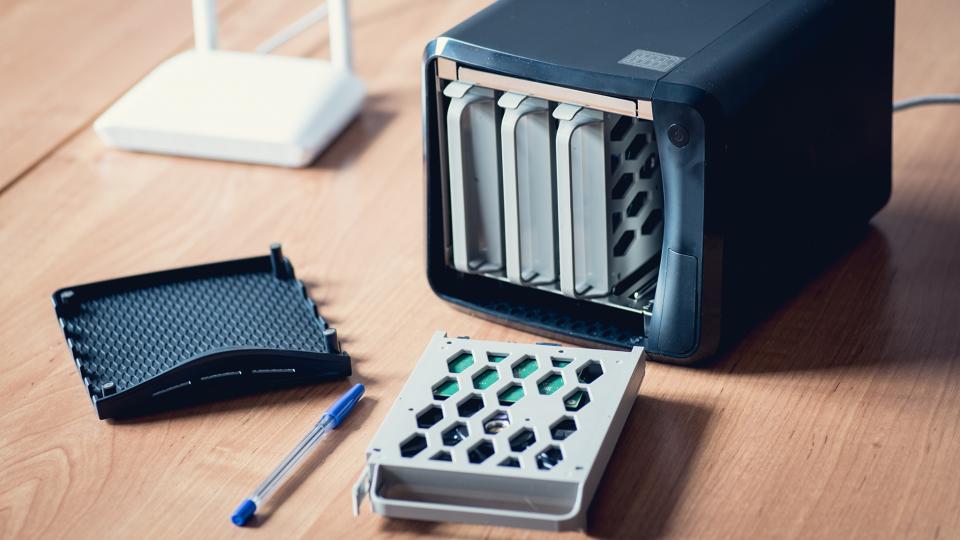
Want to store your files securely and without using the cloud? These are the best home NAS solutions out there right now
If you’re a business owner, it makes perfect sense to invest in the best NAS drive you can afford. But network-attached storage isn’t just for big businesses. In most homes today you’ll find a plethora of desktops, laptops and mobile devices – so a central repository for your important files makes sense.
It ensures that you can access your data from wherever you happen to be, even if you’re out on the road, thanks to the easy-to-use remote-access services that come as standard. And, if one of your hard drives fails, it’s good to know that a multi-disk RAID array is keeping your data safe. Better still, modern NAS appliances can also run all sorts of useful network applications, from media servers to databases, wikis and security camera management systems.
No matter what your needs, a NAS can help. We’re here to steer you towards the best NAS drives on the market right now, but before we do, here’s a guide to unscrambling the acronyms and choosing the best NAS appliance for you.
READ NEXT: Best cloud storage solutions
How to choose the best NAS drive for you
What do all the acronyms mean?
Before we begin in earnest, here’s a brief index of confusing acronyms and what they mean (for the newcomers out there):
- NAS: Network-Attached Storage – a storage device that is attached to a local network. Storage manufacturer Seagate describes NAS as “like having a private cloud in the office”, and we think that’s spot on.
- RAID: Redundant Array of Independent Disks – a method of storing the exact same data on multiple disks – in case of hardware/software failure – that also benefits performance.
- JBOD: Just a Bunch Of Disks – no, seriously. JBOD allows you to take drives of varying sizes and combine them into a single volume.
All of the NAS drives on this list support JBOD and various RAID levels, from RAID 1 to RAID 10. These levels are too complex to go into here: if you want to know more, Tech Target has a good, complicated explainer.
What type of NAS should I buy? And how many bays do I need?
NAS drives all come with a different number of drive bays, with consumer models generally coming in one, two, three or four-bay variants.
A sensible minimum is a two-bay system, using two matching hard disks in a mirrored RAID1 configuration. That way, if one drive fails, you’ll still have a copy of all your data. Don’t be tempted to rely solely on JBOD or RAID0 configurations, however: these offer more capacity, but lack fault tolerance – if one drive fails, all your data is lost.
If you’re willing to spend a bit more, a four-bay NAS drive is more versatile. With four disks, you can set up a RAID5 array, which offers a better balance of capacity and data security. In this arrangement, a portion of each disk is reserved for parity data from the other three drives (which makes it possible to rebuild the array in the event of a failure). For example, with four 1TB drives, you can store up to 3TB of data, and if any single drive should fail, you can simply drop in a replacement and carry on working.
Four-bay NAS appliances also tend to have additional features, such as more ports and LCD displays. But they’re naturally noisier and more power-hungry – as well as generally quite a bit more expensive.
What connections should I look out for?
Most NAS appliances offer one or more USB 3 ports, meaning you can hook up an external hard disk and share files over your network. There’s also often a connector at the front for one-touch copying: simply plug in a USB hard disk and press the copy button, and the contents of the external drive will be copied onto the NAS. If your data is currently scattered across a selection of external drives, it’s an easy way to consolidate all your files into one place.
You may also see HDMI and audio sockets for connecting a monitor and speakers directly to your NAS box. These let you use built-in apps to turn your appliance into a video player or audio jukebox. You may even be able to plug in a keyboard and mouse and run desktop apps on the NAS appliance – but don’t expect blazing performance as NAS hardware is quite lightweight by desktop PC standards.
How do I get the best performance?
Your NAS drive should be connected to a Gigabit Ethernet port on your router. If your router only offers 100Mbits/sec Ethernet, your speeds will be severely limited: upgrading your router would be your first step to getting the best performance.
Even with a Gigabit connection, don’t expect superfast file copies all the time. Speeds can top 100MB/sec for a single big file, but for a folder containing lots of small files, the file system overhead will mean things go a lot more slowly.
Which disks should I use?
All the NAS drives we’ve recommended below can be bought diskless. The manufacturers normally recommend you populate them with specialist NAS disks such as the WD Red series, which are designed for heavy use and high-temperature environments. For a home NAS, though, that’s probably overkill – feel free to buy cheap consumer drives or to reuse disks from decommissioned PCs. Just make sure you have spares on hand for when one inevitably gives up the ghost.
What do I need to know about add-on apps?
Most modern NAS systems include all the basic services you need to work with Windows, macOS and Linux clients. They’ll also integrate with Apple’s Time Machine backup service, and for corporate roles, many support Active Directory and iSCSI, too.
On top of this, it’s well worth having a browse at the apps available, as these can greatly extend the capabilities of your NAS appliance. Most units come with a built-in “app store”, offering dozens or even hundreds of apps that you can install with a click. These invariably include a selection of media server apps, enabling your NAS to stream audio and video to smart devices in your home. You’ll also find business and development tools, surveillance apps that work with IP cameras and even content management systems such as WordPress.
One caveat: if you enable a whole load of apps and services, the hardware might start to struggle. If that’s a concern for you, pick a model with a powerful Intel processor and plenty of RAM, or one where you can fit extra memory as needed. If you’re not sure how much headroom you have, there’s normally an activity monitor within the appliance’s web interface, exposing what’s using its CPU and RAM, so you can spot any services that might be overtaxing your hardware.
Can I access my files remotely?
With the correct setup, you can access your NAS appliance from anywhere in the world. It’s a great alternative to cloud services such as Dropbox and Google Drive, with no monthly fee and a lot more storage. Every provider offers a bespoke service, typically web-based, which makes it effortless to securely access your files from a web browser.
Many providers also offer some degree of integration with third-party cloud services, meaning files in a certain folder on your NAS appliance can be automatically synchronised with your Dropbox account – and vice versa. This is handy if, for example, you want to use a printer or scanner that features Dropbox integration, as it saves you having to mess around moving files back and forth between services.
Is the data on my NAS completely safe?
Even RAID isn’t infallible. Your NAS box could be fried by a serious electrical fault or stolen in a break-in. Many NAS systems come with integrated support for offsite backup systems such as Amazon S3 or ElephantDrive, although these aren’t free. Alternatively, if you have access to a NAS appliance in a second location, most units will let you automatically replicate your data over the internet.
The other thing to remember is that a modern NAS is effectively a small computer, which means it’s vulnerable to hackers and malware just like any other computer. Install system updates as soon as they become available – most NAS appliances can do this automatically in the middle of the night to minimise disruption – and make sure your apps and services are up to date. That goes for all the other computers in your home, too – we’ve seen PC-based ransomware that specifically targets NAS appliances and you definitely don’t want to get caught by that.
READ NEXT: Best external hard disks
The best NAS drives to buy
1. Asustor Nimbustor AS5304T: Best NAS drive for streaming
Price: £459 (diskless) | Buy now from Amazon
If you’re looking for a NAS for business or mainstream home use, consider any of the other NAS drives on this list. But if you’re looking for a great four-bay NAS for streaming, media and more, the AS5304T is the best by a country mile; By looking beyond the usually conservative NAS market, Asustor has produced something really special.
Powered by a blazingly quick quad-core Intel Celeron J4105 supported by up to 8GB of RAM, the AS5304T aced our 4K media benchmarks, even when running over a standard gigabit ethernet network. It has space for four drives, and supports a wealth of RAID configurations; you’ll even find an HDMI port on the back for those days when you really badly want to use it as a Linux desktop PC.
With dashing good looks (for a NAS drive) and onboard software that’s perfect for developers, our only complaint about the AS5304T is the price – if you have the cash to blow on a stunningly good media streaming NAS, this is the device for you.
Key specs – CPU: Intel Celeron J4105 (1.5GHz to 2.5GHz, quad-core); RAM: 4/8GB; Drive bays: 4; RAID modes: JBOD, RAID0, RAID1, RAID5, RAID6, RAID10; Gigabit Ethernet connectors: 2 x 2.5GbE; Data connectors (rear): 2 x USB3.2; Data connectors (front): USB3.2; Other connectors: HDMI; Dimensions (WDH): 174 x 230 x 170mm; Warranty: 3yr RTB
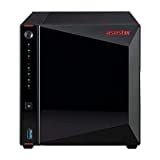
Asustor NIMBUSTOR 4 AS5304T 4 Bay NAS Enclosure – Network Attached Storage, Quad-Core 1.5GHz, 4GB RAM DDR4, Personal Private Cloud (Diskless)
£479.99 Buy now 

Asustor AS5304T | Gaming Inspired Network Attached Storage | 1.5GHz Quad-Core, Two 2.5GbE Port, 4GB RAM DDR4, 4GB eMMC Flash Memory | Personal Private Cloud (4 Bay Diskless NAS)
2. QNAP TS-251B-4G: Best value NAS drive
Price: £307 | Buy now from Amazon
QNAP’s unassuming TS-251B-4G NAS drive is brimming with features. With an Intel Celeron J3355 processor and 4GB of RAM, it’s relatively well-specced. Pair those innards with three audio outputs, three USB ports and an HDMI video port, however, and you’ve got yourself a bona-fide miniature PC; simply plug in a monitor, mouse and keyboard to complete the experience. There’s even room for an NVMe SSD and a wireless network card.
The TS-251B-4G makes it exceptionally simple to remove and reinstall drives via the two clip-in caddies mounted behind the left-hand panel. QNAP’s preinstalled software offers a pared-down desktop experience for media playback and web browsing, as well as a useful slew of data backup, file sync and surveillance tools and an app store stocked to the brim. It’s not as fast as some of the others on this list, but in terms of value for money, the TS-251B-4G is unbeatable.
Key specs – CPU: Intel Celeron J3355 (2GHz, dual-core); RAM: 4GB; Drive bays: 2; RAID modes: JBOD, RAID0, RAID1; Gigabit Ethernet connectors: 1; Data connectors (rear): USB 3, 3 x USB 2; Data connectors (front): USB 3; Other connectors: 1 x HDMI, 3 x audio jack; Dimensions (WDH): 105 x 226 x 168mm; Warranty: 2yr RTB
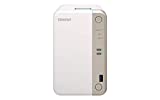
QNAP TS-251B-4G, 2bay, 4GB RAM, Intel Dual-core CPU, PCIe slot x1, ideal NAS (Network-attached Storage) Enclosure, private cloud, backup, data centre
3. Asustor AS6404T: Best high-end NAS drive
Price: £510 (diskless) | Buy now from Laptops Direct
The AS6404T is a high-end appliance with a two-line LCD display on the front and a powerful quad-core Intel Celeron J3455 inside. It’s easy to use, thanks to Asustor’s slick ADM web interface, and it supports all the important network protocols and services. We had no problem accessing our music library through iTunes, nor streaming Full HD video through Plex – although there are plenty of alternative video playback options for those who prefer them, including DLNA, Kodi and Apple AirPlay. Remote access is handled by Asustor’s own Cloud Connect service, while the Surveillance Center app will monitor up to four IP cameras for free.
Thanks to HDMI and twin USB connectors at the rear, it’s even possible to use this NAS as a standalone audio and video centre or run a full Linux desktop. The 8GB of RAM isn’t huge for this sort of role, but it’s enough for lightweight computing.
The only catch is the price: yes, you get a lot for your money, but for everyday NAS duties, there are much cheaper options. Still, there’s nothing wrong with buying more power and flexibility than you need right now – and, with its four drive bays and two Gigabit Ethernet ports, the AS6406T should serve your needs for a very long time.
Key specs – CPU: Intel Celeron J3455 (1.5GHz, 2.3GHz burst, quad-core); RAM: 8GB; Drive bays: 4; RAID modes: Single, JBOD, RAID0, RAID1, RAID5, RAID6, RAID10; Gigabit Ethernet connectors: 2; Data connectors (rear): 2 x USB 3, USB-C; Data connectors (front): USB 3; Other connectors: HDMI, S/PDIF; Dimensions (WDH): 170 x 230 x 186mm; Warranty: 3yr RTB
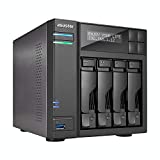
ASUSTOR 90IX0121-BW3S10 as6404t Network Attached Storage Drive – Black
£530.00 Buy now 
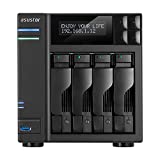
Asustor AS6404T, 4-Bay, Intel Celeron J3455 Quad-Core 1.5 GHz, 8GB RAM
$459.00 Buy now
4. TerraMaster F5-221: Best cheap five-bay NAS drive
Price: £320 (diskless) | Buy now from Amazon
As five-bay NAS appliances go, the TerraMaster F5-221 is an inexpensive option that ticks several important boxes. Courtesy of an Intel Celeron J1800 processor (backed up by 2 to 4GB of RAM), the F5-221 is no slouch, performing admirably in file transfer and media benchmark tests. The headline feature is of course the five drive bays, which are cooled by two 82mm fans; it’s a little unlikely that you’ll fill all five at once, meaning the F5-221 is good for an upgrade further down the line.
While TerraMaster’s NAS software isn’t as slick as Asus’s or Synology’s, it’s quite well-designed, giving you easy access to the usual management tools and features, useful dashboards and an app store with a bewildering range of add-on apps. We did experience a few niggling setup issues, but assuming everything goes smoothly, this is a good NAS for big demands and small wallets.
Key specs – CPU: Intel Celeron J1800 (2.4 to 2.58GHz dual-core); RAM: 2/4GB; Drive bays: 5; RAID modes: Single, JBOD, RAID0, RAID1, RAID5, RAID6, RAID10; Gigabit Ethernet connectors: 2; Data connectors (rear): 2 x USB 3; Data connectors (front): None; Other connectors: None; Dimensions (WDH): 225 x 227 x 136mm; Warranty: 2yr RTB
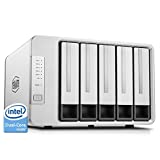
TerraMaster F5-221 NAS 5 bay Cloud Storage Intel Dual Core 2.0GHz Plex Media Server Network Storage (Diskless)
£319.99 Buy now 

5. WD My Cloud Pro PR4100: Best mid-range NAS drive
Price: £460 (diskless) | Buy now from Amazon
The My Cloud PR4100 looks pretty swish, with its two-line LCD status display and inset navigation buttons that let you cycle through various bits of system information. The web interface, meanwhile, is clean and accessible, ditching the familiar windowed approach in favour of a simple tab-driven graphical interface
A decent selection of add-ons is supported, including media servers, a surveillance service and a decent selection of productivity and techie extensions. If you want to get ambitious, you can upgrade the RAM to 16GB if you wish – although there’s no way to play media locally, nor any support for desktop apps or virtualisation, which does raise the question of what WD thinks you might need all that memory for.
For a four-bay appliance, £490 is still a relatively competitive price, but we’ve one word to the wise: pre-populated models can work out more expensive than buying the bare enclosure and picking your drives separately, so investigate your options before buying.
Key specs – CPU: Intel Pentium N3710 (1.6GHz, 2.56GHz burst, quad-core); RAM: 4GB; Drive bays: 4; RAID modes: JBOD, RAID0, RAID1, RAID5, RAID10; Gigabit Ethernet connectors: 2; Data connectors (rear): 2 x USB 3; Data connectors (front): USB 3; Other connectors: None; Dimensions (WDH): 170 x 232 x 192mm; Warranty: 2yr RTB (diskless), 3yr RTB (populated)
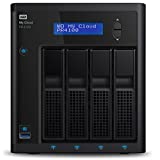
Western Digital Diskless My Cloud Pro PR4100 Professional Series 4-Bay Network Attached Storage – NAS – WDBNFA0000NBK-EESN
£459.97 Buy now 

5. Synology DS1019+: Best five-bay NAS drive
Price: £706 | Buy now from Amazon
Synology’s flagship five-bay NAS drive is a thing of beauty. Installing drives is straightforwardly done via the clip-mounted drive bays on the front of the device – no screwdriver required. Upgrading the DS1019+ is equally simple, and you might be surprised by the options available; this NAS has an eSATA port for a Synology DX517 expansion unit (to effectively double capacity) and space to slot in two M.2 NVMe SSDs for use as a cache.
It lacks the HDMI video output and keyboard/mouse inputs of some of the other NAS appliances on this list, but the DS1019+ isn’t trying to be a desktop PC; its feature set is aimed squarely at those who need a powerful, secure server for work purposes. Two Gigabit ethernet ports offer extra protection against network failure, while an impressive showing in our sequential read/write tests guarantees that this NAS can compete with the fastest products out there.
Better still, Synology’s operating software is our favourite of the bunch. From the straightforward setup process to the plethora of supported cloud storage options (including AWS, Microsoft Azure, Dropbox and Google Drive) the OS rounds out an impressive feature set. If you aren’t baulking at the price, this is one seriously versatile NAS.
Key specs – CPU: Intel Celeron J3455; RAM: 8GB; Drive bays: 5; RAID modes: SHR, JBOD, RAID0, RAID1, RAID5, RAID6, RAID10; Gigabit Ethernet connectors: 2; Data connectors (rear): 1 x USB 3; Data connectors (front): 1 x USB 3; Other connectors: eSATA; Dimensions (WDH): 223 x 230 x 166mm; Warranty: 2yr RTB
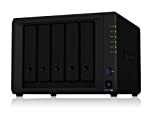
Synology DS1019+ 5 Bay Desktop NAS Enclosure ,Black
£706.21 Buy now
